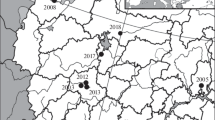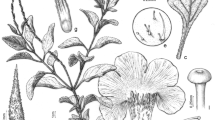Abstract
The largest family of Solanaceae counts many species widespread worldwide, either wild and cultivated. A lot of cultivated species of this family represent an important part of the world of food. These and other spontaneous plants have several ethnobotanical uses. In this paper, the author reports for the first time about the presence, as casual alien species, of Solanum torvum Sw. in Europe (Calabria region, Southern Italy). Actually, it was reported in Italy by mistake until then. This species is native of West Indies and naturalized in several tropical and subtropical regions worldwide. S. torvum, also used as rootstock for cultivated Solanaceae, can escape and invade natural habitats, replacing the natural vegetation and creating changes in relationships with other species. Twenty-three plants of S. torvum are located in a stream, living together with other alien and synanthropic species. This work deals with its geographical distribution and new location, with its morphological, ecological and taxonomic characteristics. S. torvum, can be considered in Italy and in Europe as an alien casual species, but further field investigations on this species are necessary to avoid its diffusion.




Similar content being viewed by others
References
Applequist WL (2013) Report of the nomenclature committee for vascular plants: 65. Taxon 62:1315–1326
Bartolucci F, Peruzzi L, Galasso G, Albano A, Alessandrini A, Ardenghi NMG, Astuti G, Bacchetta G, Ballelli S, Banfi E, Barberis G, Bernardo L, Bouvet D, Bovio M, Cecchi L, Di Pietro R, Domina G, Fascetti S, Fenu G, Festi F, Foggi B, Gallo L, Gottschlich G, Gubellini L, Iamonico D, Iberite M, Jiménez-Mejías P, Lattanzi E, Marchetti D, Martinetto E, Masin RR, Medagli P, Passalacqua NG, Peccenini S, Pennesi R, Pierini B, Poldini L, Prosser F, Raimondo FM, Roma-Marzio F, Rosati L, Santangelo A, Scoppola A, Scortegagna S, Selvaggi A, Selvi F, Soldano A, Stinca A, Wagensommer RP, Wilhalm T, Conti F (2018) An updated checklist of the vascular flora native to Italy. Plant Biosyst 152(2):179–303. https://doi.org/10.1080/11263504.2017.1419996
Bartolucci F, Domina G, Alessandrini A et al (2019) Notulae to the Italian native vascular flora: 7. Ital Bot 7:125–148. https://doi.org/10.3897/italianbotanist.7.36148
Bernardo L (2000) Fiori e piante del Parco del Pollino, 2a edn. Prometeo, Castrovillari (CS)
Bernardo L, Puntillo D (2002) Le orchidee spontanee della Calabria. Prometeo, Castrovillari (CS)
Bernardo L, Peruzzi L, Passalacqua NG (2011) Flora vascolare della Calabria: Prodromo. Inform Bot Ital 43(2):185–332
Bilotta M, Morra L, Verazza A (2006) Solanum torvum si conferma portinnesto ideale per melanzana. L’Informatore Agrario 49:31–34
Blasi C, Michetti L (2005) Biodiversity and climate. In “Biodiversity in Italy”. Blasi C. (Ed. in chief). Roma
Brullo S, Scelsi F, Spampinato G (2011) La vegetazione dell’Aspromonte. Laruffa Editore, Reggio Calabria
CABI (2019) Invasive Species Compendium. CAB International, Wallingford. https://www.cabi.org/ISC/datasheet/50559#779A2AA4-CECA-400A-86DD-2C522152AB0B. Accessed 27 April 2019
Cambria S, Banfi E, Verloove F, Domina G (2015) Solanum lanceolatum (Solanaceae) in Sicily: a new alien species for the European flora. Fl Medit 25:115–120. https://doi.org/10.7320/FlMedit25.115
Cano E, Musarella CM, Cano-Ortiz A, Piñar Fuentes JC, Spampinato G, Pinto Gomes C (2017) Morphometric analysis and bioclimatic distribution of Glebionis coronaria s.l. (Asteraceae) in the Mediterranean area. Phytokeys 81:103–126. https://doi.org/10.3897/phytokeys.81.11995
Crisafulli A, Cannavò S, Maiorca G, Musarella CM, Signorino G, Spampinato G (2010) Aggiornamenti floristici per la Calabria. Inform Bot Ital 42(2):437–448
Daunay MC (2008) Eggplant. In: Prohens J, Nuez F (eds) Handbook of plant breeding: vegetables II. Springer, New York, pp 163–220
Fedorov A (1969) Chromosome numbers of flowering plants. Leningrad, V.L, Komarov Botanical Institute
Galasso G, Conti F, Peruzzi L et al (2018) An updated checklist of the vascular flora alien to Italy. Plant Biosyst 152(3):556–592. https://doi.org/10.1080/11263504.2018.1441197
Galasso G, Domina G, Ardenghi NMG, Aristarchi C et al (2019) Notulae to the Italian alien vascular flora: 7. Ital Bot 7:157–182. https://doi.org/10.3897/italianbotanist.7.36386
Gisbert C, Prohens J, Raigón MD, Stommel JR, Nuez F (2011) Eggplant relatives as sources of variation for developing new rootstocks: effects of grafting on eggplant yield and fruit apparent quality and composition. Sci Hortic 128:14–22. https://doi.org/10.1016/j.scienta.2010.12.007
Gousset C, Collonnier C, Mulya K, Mariska I, Rotino GL, Besse P, Servaes A, Sihachakr D (2005) Solanum torvum, as a useful source of resistance against bacterial and fungal diseases for improvement of eggplant (S. melongena L.). Plant Sci 168(2):319–327. https://doi.org/10.1016/j.plantsci.2004.07.034
Hammer K, Laghetti G (2006) Small agricultural islands and plant genetic resources. C.N.R., Bari
King SR, Davis AR, Zhang X, Crosby K (2010) Genetics, breeding and selection of rootstocks for Solanaceae and Cucurbitaceae. Sci Hortic 127:106–111. https://doi.org/10.1016/j.scienta.2010.08.001
Knapp S (2009) Synopsis and lectotypification of Solanum (Solanaceae) species endemic in the West Indies. An Jardin Bot Madrid 66(1):65–84. https://doi.org/10.3989/ajbm.2209
Knapp S (2011) Proposal to conserve the name Solanum torvum (Solanaceae) with a conserved type. Taxon 60:1523–1524
Knapp S, Vorontsova MS, Särkinen T (2019) Dichotomous keys to the species of Solanum L. (Solanaceae) in continental Africa, Madagascar (incl. the Indian Ocean islands), Macaronesia and the Cape Verde Islands. PhytoKeys 127:39–76. https://doi.org/10.3897/phytokeys.127.34326
Kunkar A, Kunkar E (2000) Le piante officinali in Calabria e loro possibile utilizzo. Laruffa Editore, Reggio Calabria
Leporatti ML, Impieri M (2007) Ethnobotanical note about some uses of medicinal plants in Alto Tirreno Cosentino area (Calabria, Southern Italy). J Ethnobiol Ethnomed 3:34. https://doi.org/10.1186/1746-4269-3-34
Lupia C, Lupia R (2013) Etnobotanica: piante e tradizioni popolari di Calabria. Grafi.Co s.r.l, Crotone
Mallol A, Maynés J (2008) Nous xenòfits al baix empordà (Catalunya). Acta Bot Barc 51:59–77
Maruca G, Spampinato G, Turiano D, Laghetti G, Musarella CM (2019) Ethnobotanical notes about medicinal and useful plants of the Reventino Massif tradition (Calabria region, Southern Italy). Genet Resour Crop Evol. https://doi.org/10.1007/s10722-019-00768-8
Musarella CM, Tripodi G (2004) La flora della rupe e dei ruderi di Pentidattilo (RC). Inform Bot Ital 36(1):3–12
Musarella CM, Cano-Ortiz A, Piñar Fuentes JC, Navas-Ureña J, Pinto Gomes CJ, Quinto-Canas R, Cano E, Spampinato G (2018) Similarity analysis between species of the genus Quercus L. (Fagaceae) in southern Italy based on the fractal dimension. PhytoKeys 113:79–95. https://doi.org/10.3897/phytokeys.113.30330
Musarella CM, Paglianiti I, Spampinato G (2019) Ethnobotanical study in the Poro and Preserre Calabresi territory (Vibo Valentia. Atti Soc Tosc Sci Nat, Mem, Serie B, S-Italy). https://doi.org/10.2424/ASTSN.M.2018.17
Musarella CM, Laface VLA, Morabito A, Cano-Ortiz A, Cannavò S, Spampinato G (in press a) Aggiornamenti sulla flora alloctona calabrese: novità e conferme. Notiziario della Società Botanica Italiana XX:XXX–XXX
Musarella CM, Stinca A, Laface VLA, Petrilli R, Spampinato G (in press b) New data on the alien vascular flora of Calabria (southern Italy)
Panuccio MR, Fazio A, Musarella CM, Mendoza-Fernández AJ, Mota JF, Spampinato G (2018) Seed germination and antioxidant pattern in Lavandula multifida (Lamiaceae): a comparison between core and peripheral populations. Plant Biosyst 152(3):398–406. https://doi.org/10.1080/11263504.2017.1297333
Passalacqua NG, De Fine G, Guarrera PM (2006) Contribution to the knowledge of the veterinary science and of the ethnobotany in Calabria region (Southern Italy). J Ethnobiol Ethnomed 2:52. https://doi.org/10.1186/1746-4269-2-52
Passalacqua NG, Guarrera PM, De Fine G (2007) Contribution to the knowledge of the folk plant medicine in Calabria region (Southern Italy). Fitoterapia 78(1):52–68. https://doi.org/10.1016/j.fitote.2006.07.005
Perrino EV, Calabrese G (2018) Endangered segetal species in southern Italy: distribution, conservation status, trends, actions and ethnobotanical notes. Genet Resour Crop Evol 65:2107–2134. https://doi.org/10.1007/s10722-018-0678-6
Petran A, Hoover E (2014) Solanum torvum as a Compatible Rootstock in Interspecific Tomato Grafting. J Hortic 1:103. https://doi.org/10.4172/2376-0354.1000103
Pyšek P, Richardson DM, Rejmánek M, Webster GL, Williamson M, Kirschner J (2004) Alien plants in checklists and floras: towards better communication between taxonomists and ecologists. Taxon 53:131–143
Raimondo FM, Orlando A (1978) Prima segnalazione in Italia di Solanum torvum Sw. Inform Bot Ital 10(1):43–45
Randell BR, Symon DE (1976) Chromosome numbers in Australian Solanum species. Aust J Bot 24:369–379
Rivas-Martínez S, Rivas-Saenz S (1996–2019) Worldwide bioclimatic classification system. Phytosociological Research Center, Spain. http://www.globalbioclimatics.org. Accessed 27 April 2019
Rivas-Martínez S, Penas A, Díaz TE (2004) Bioclimatic and biogeographic maps of Europe. http://www.globalbioclimatics.org/form/maps.htm. Accessed 27 April 2019
Rondon SI (2010) The potato tuberworm: a literature review of its biology, ecology, and control. Am J Pot Res 87:149–166. https://doi.org/10.1007/s12230-009-9123-x
Salerno G, Stinca A (2017) First European record of Solandra maxima (Sessé & Moc.) P.S.Green (Solanaceae). Ann Bot 7:67–70. https://doi.org/10.4462/annbotrm-13848
Signorino G, Cannavò S, Crisafulli A, Musarella CM, Spampinato G (2011) Fagonia cretica L. Schede per una Lista Rossa della Flora vascolare e crittogamica Italiana. Inform Bot Ital 43(2):381–458
Sobrino Vesperinas E, Sanz Elorza M (2012) Solanum L. In: Castroviejo S (ed) Flora iberica: plantas vasculares de la Península Ibérica e Islas Baleares, vol 11. Real Jardín Botánico, CSIC, Madrid, pp 166–195
Spampinato G (2014) Guida alla flora dell’Aspromonte. Laruffa Editore, Reggio Calabria
Spampinato G, Crisarà R, Cannavò S, Musarella CM (2017) Phytotoponims of southern Calabria: a tool for the analysis of the landscape and its transformations. Att Soc Tosc Sci Nat Mem Ser B 124:61–72. https://doi.org/10.2424/ASTSN.M.2017.06
Spampinato G, Musarella CM, Cano-Ortiz A, Signorino G (2018) Habitat, occurrence and conservation status of the Saharo-Macaronesian and Southern-Mediterranean element Fagonia cretica L. (Zygophyllaceae) in Italy. J Arid Land 10(1):140–151. https://doi.org/10.1007/s40333-017-0076-5
Spampinato G, Massimo DE, Musarella CM, De Paola P, Malerba A, Musolino M (2019) Carbon sequestration by cork oak forests and raw material to built up post carbon city. In: Calabrò F, DellaSpina L, Bevilacqua C (eds) New metropolitan perspectives. ISHT 2018. Smart innovation, systems and technologies, vol 101. Springer, Cham. https://doi.org/10.1007/978-3-319-92102-0_72
Stern SR, de Agra MF, Bohs L (2011) Molecular delimitation of clades within New World species of the “spiny solanums” (Solanum subgenus Leptostemonum). Taxon 60:1429–1441
Stinca A, D’Auria G, Motti R (2012) Integrazioni alla flora vascolare aliena della Campania (Sud Italia). Inform Bot Ital 44(2):287–293
Stinca A, Croce A, D’Auria G, Salerno G, Santangelo A, Rosati L, Motti R (2016a) Nuovi dati sulla flora vascolare aliena della Campania (Sud Italia) [New data on the alien vascular flora of Campania (South Italy)]. Att Soc Tosc Sci Nat Mem Ser B 122(2015):89–110. https://doi.org/10.2424/ASTSN.M.2015.09
Stinca A, Galasso G, Banfi E (2016b) First Italian record of Paspalum notatum Flüggé (Poaceae) and its typification. Acta Bot Croat 75(1):153–156. https://doi.org/10.1515/botcro-2016-0012
Stinca A, Chianese G, D’Auria G, Del Guacchio E, Fascetti S, Perrino EV, Rosati L, Salerno G, Santangelo A (2017) New alien vascular species for the flora of southern Italy. Webbia 72(2):295–301. https://doi.org/10.1080/00837792.2017.1349236
Swartz O (1788) Nova genera & species plantarum; seu, Prodromus descriptionum vegetabilium, maximam partem incognitorum, 2nd edn. Pritzel, Holmiae, p 47. https://doi.org/10.5962/bhl.title.4400
Tagarelli G, Tagarelli A, Piro A (2010) La medicina popolare usata per curare la malaria in Calabria (Italia meridionale). J Ethnobiol Ethnomed 6:27. https://doi.org/10.1186/1746-4269-6-27
Thiers B (2019) Index Herbariorum: a global directory of public herbaria and associated staff. The New York Botanical Garden, New York. http://sweetgum.nybg.org/ih/. Accessed 29 April 2019
Valdés B (2012) Solanaceae. In: Euro + Med Plantbase—the information resource for Euro-Mediterranean plant diversity. Published on the Internet http://ww2.bgbm.org/EuroPlusMed/ Accessed 29 April 2019
Vorontsova MS, Knapp S (2014) Solanum torvum. In: Solanaceae source. Knapp (ed). http://www.solanaceaesource.org/content/solanum-torvum. Accessed 27 April 2019
Vorontsova MS, Knapp S (2016) A revision of the spiny solanums, Solanum subgenus Leptostemonum (Solanaceae) in Africa and Madagascar. Systematic Botany Monographs, 99. The American Society of Plant Taxonomists
VVAA (1967) Carta Geologica della Calabria Scala 1: 25.000. Servizio Geologico Italiano. Cassa per opere di pubblico interesse nell’Italia meridionale (Cassa per il Mezzoggiorno). Rilevamento Geologico Compagnia Aero-Ricerche
Witt A, Luke Q (2017) Guide to the naturalized and invasive plants of Eastern Africa. In: Witt A, Luke Q (eds) CABI, Wallingford, UK. vi+601 pp. http://www.cabi.org/cabebooks/ebook/20173158959 https://doi.org/10.1079/9781786392145.0000. Accessed 27 April 2019
Acknowledgements
The author is very grateful to Stefania Griso for the linguistic revision of the text.
Author information
Authors and Affiliations
Corresponding author
Ethics declarations
Conflict of interest
The authors declare that they have no conflict of interest.
Human and animal rights
This Research involved Human Participants who gave a verbal informed consent prior to the interview.
Additional information
Publisher's Note
Springer Nature remains neutral with regard to jurisdictional claims in published maps and institutional affiliations.
Rights and permissions
About this article
Cite this article
Musarella, C.M. Solanum torvum Sw. (Solanaceae): a new alien species for Europe. Genet Resour Crop Evol 67, 515–522 (2020). https://doi.org/10.1007/s10722-019-00822-5
Received:
Accepted:
Published:
Issue Date:
DOI: https://doi.org/10.1007/s10722-019-00822-5




